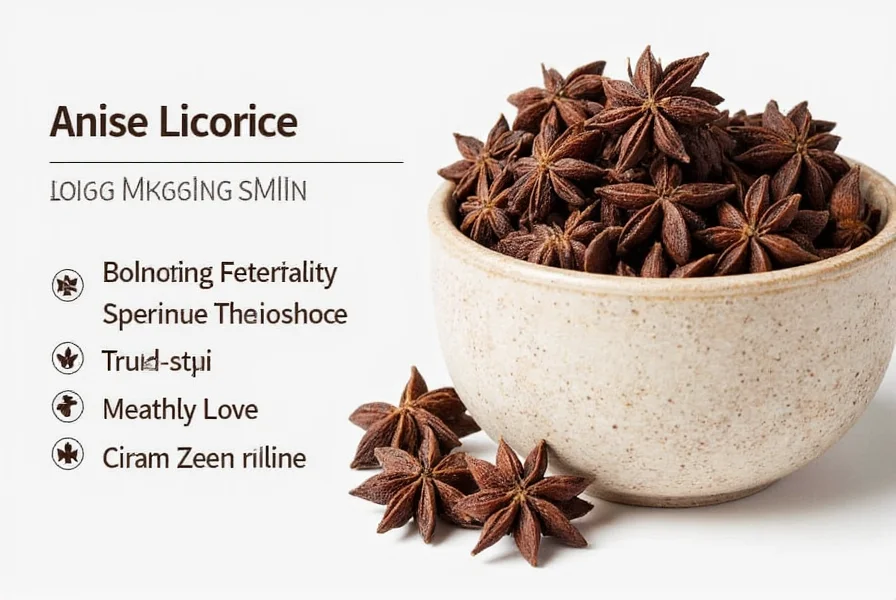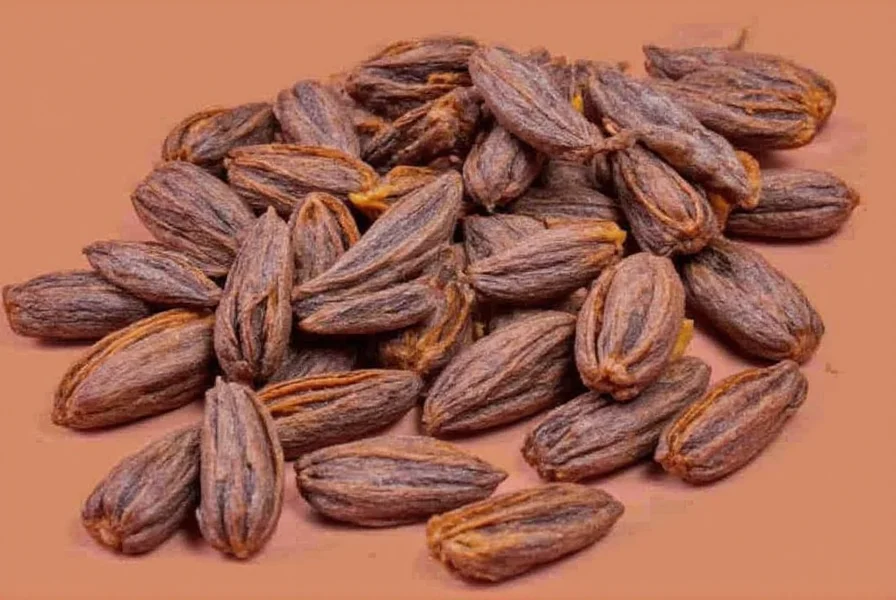When you taste anise, you'll immediately notice its pronounced licorice character—similar to what you'd experience in black licorice candy, but with more complexity. The flavor unfolds in layers: a sweet initial impression followed by warm spice notes, then a clean, refreshing finish. Unlike artificial licorice flavors, true anise seed offers a more nuanced, natural taste experience that doesn't overwhelm the palate when used appropriately.
Understanding Anise Flavor Components
Anise seed's distinctive taste comes primarily from anethole, the same compound found in fennel and star anise. However, anise contains the highest concentration of this compound, giving it the most intense licorice flavor among related spices. When properly used in cooking, anise adds depth without dominating other flavors.
| Flavor Component | Intensity (1-5) | Notes |
|---|---|---|
| Licorice/Sweet | 5 | Primary characteristic, similar to natural licorice root |
| Warm Spice | 3 | Subtle peppery notes reminiscent of mild cinnamon |
| Floral | 2 | Faint herbal undertones that emerge after initial taste |
| Bitter | 1 | Only noticeable when overused or burned |
Anise vs. Similar Flavors: What Makes It Unique
Many people confuse anise with star anise, fennel, and actual licorice root. While they share the characteristic licorice flavor due to anethole, each has distinct differences:
Anise seed (Pimpinella anisum) delivers the most intense, pure licorice flavor with noticeable sweetness. The seeds are small, grayish-brown, and crescent-shaped.
Star anise (Illicium verum) has a similar but more woody, less sweet flavor profile. This Chinese spice comes from a different plant family and features a distinctive star-shaped pod.
Fennel seed offers a milder, more herbal licorice note with pronounced vegetable-like qualities. It's commonly used in Italian sausages and Mediterranean cuisine.
Licorice root (Glycyrrhiza glabra) provides the strongest, most medicinal licorice flavor with significant sweetness from glycyrrhizin.

How Preparation Affects Anise Flavor
The way you prepare anise dramatically impacts its flavor expression in dishes:
- Whole seeds: Release flavor gradually when heated, ideal for slow-cooked dishes and baking
- Ground anise: Provides immediate, more intense flavor but loses potency quickly
- Dry-toasted: Enhances sweetness and reduces bitterness
- Raw consumption: Delivers the most intense, almost medicinal licorice hit
Professional chefs recommend blooming whole anise seeds in oil or dry-toasting them before use to maximize flavor extraction while minimizing any potential bitterness. The optimal temperature range for anise is between 300-350°F (150-175°C)—beyond this, the delicate flavor compounds can burn and turn unpleasantly bitter.
Culinary Applications and Pairing Suggestions
Anise works beautifully in both sweet and savory applications when used with precision. In baking, it complements citrus flavors, chocolate, and other warm spices like cinnamon and cloves. The classic Italian biscotti ricciarelli showcases anise perfectly alongside almond flour.
In savory dishes, anise seed enhances tomato-based sauces, braised meats, and certain seafood preparations. It's a key component in Chinese five-spice powder and French herbes de Provence. When pairing anise with other ingredients, remember that less is often more—typically 1/4 to 1/2 teaspoon of ground anise or 1/2 to 1 teaspoon of whole seeds suffices for most recipes serving 4-6 people.

Sensory Experience Breakdown
When tasting pure anise seed, the flavor experience unfolds in three distinct phases:
- Initial impression: Immediate sweet licorice burst that coats the tongue
- Middle palate: Warm spice notes emerge with subtle peppery undertones
- Finish: Clean, slightly floral aftertaste that lingers pleasantly for 30-60 seconds
This progression makes anise particularly valuable in recipes where you want flavor complexity that evolves as someone eats. Unlike artificial licorice flavors that often leave an unpleasant chemical aftertaste, properly used anise creates a harmonious flavor journey.
Common Misconceptions About Anise Flavor
Several misconceptions persist about anise's taste profile. Many believe anise and star anise are identical—they're not, as star anise has a more woody, less sweet profile. Others think anise is always overpowering, but when used judiciously (typically 1/4-1/2 teaspoon per serving), it enhances rather than dominates.
Another common misunderstanding is that anise has significant bitterness. While overuse or burning can create bitterness, properly prepared anise is predominantly sweet with only subtle spicy notes. Understanding these nuances helps home cooks use anise more effectively in their recipes.
Practical Usage Tips for Home Cooks
When incorporating anise into your cooking, start with smaller amounts than recipes suggest and adjust to taste. Whole seeds maintain their flavor longer than ground anise—store them in an airtight container away from light for up to two years. For baking applications, lightly toast whole seeds before grinding to maximize flavor release.
Remember that anise flavor intensifies slightly during cooking, so it's better to add it toward the end of the cooking process in liquid-based dishes. In doughs and batters, distribute the seeds evenly to prevent concentrated pockets of intense flavor. When substituting between anise and star anise, use 1 whole star anise pod for every 1/2 teaspoon of anise seeds, but expect a slightly different flavor profile.
Is anise supposed to taste like black licorice candy?
Yes, anise has a natural licorice flavor similar to black licorice candy, but higher quality than many artificial versions. The compound anethole creates this characteristic taste. Natural anise offers more complexity with sweet, warm, and slightly floral notes compared to the sometimes one-dimensional flavor of commercial licorice candies.
Why does anise taste bitter to some people?
Anise can taste bitter when used in excess, burned during cooking, or when the seeds are old and stale. Properly prepared anise should be predominantly sweet with only subtle spicy notes. To avoid bitterness, use fresh seeds, don't exceed recommended amounts (typically 1/4-1/2 teaspoon per serving), and avoid high heat that can burn the delicate flavor compounds.
How does anise compare to fennel in flavor profile?
While both contain anethole and have licorice notes, anise has a much stronger, sweeter licorice flavor, while fennel offers a milder, more herbal taste with pronounced vegetable-like qualities. Anise is primarily used as a spice, whereas fennel bulb is treated as a vegetable. The seeds differ visually too—anise seeds are smaller, grayish-brown crescents, while fennel seeds are larger and greenish.
Can I substitute star anise for anise seed in recipes?
Yes, but with adjustments. One whole star anise pod generally equals about 1/2 teaspoon of anise seeds, though star anise has a more woody, less sweet flavor profile. Star anise works better in long-simmered dishes like stews and braises, while anise seed is preferable in baking and quicker-cooking applications. The substitution isn't perfect due to their different flavor compounds, but it can work in a pinch.
Does anise taste different when used in sweet versus savory dishes?
Yes, anise's flavor profile shifts depending on the dish type. In sweet applications like cookies or cakes, its natural sweetness is enhanced and the licorice notes shine. In savory dishes like tomato sauces or braised meats, the spice notes become more prominent while the sweetness balances acidity. The fat content in dishes also affects perception—higher fat dishes like creamy sauces can mellow anise's intensity.










 浙公网安备
33010002000092号
浙公网安备
33010002000092号 浙B2-20120091-4
浙B2-20120091-4